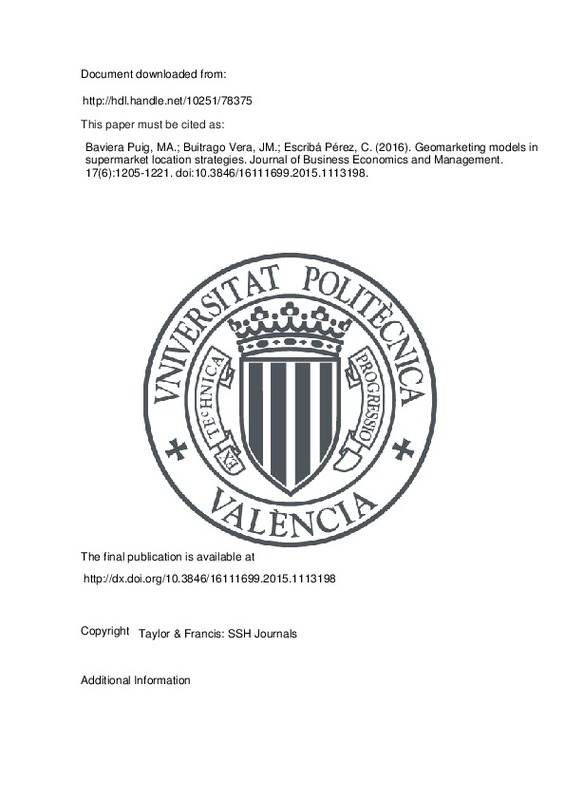Applebaum, W. (1966). Methods for Determining Store Trade Areas, Market Penetration, and Potential Sales. Journal of Marketing Research, 3(2), 127. doi:10.2307/3150201
Baviera-Puig, A., Roig-Tierno, N., Buitrago-Vera, J., & Mas-Verdu, F. (2013). Comparing trade areas of technology centres using ‘Geographical Information Systems’. The Service Industries Journal, 33(7-8), 789-801. doi:10.1080/02642069.2013.740467
Blattberg, R. C., & Hoch, S. J. (1990). Database Models and Managerial Intuition: 50% Model + 50% Manager. Management Science, 36(8), 887-899. doi:10.1287/mnsc.36.8.887
[+]
Applebaum, W. (1966). Methods for Determining Store Trade Areas, Market Penetration, and Potential Sales. Journal of Marketing Research, 3(2), 127. doi:10.2307/3150201
Baviera-Puig, A., Roig-Tierno, N., Buitrago-Vera, J., & Mas-Verdu, F. (2013). Comparing trade areas of technology centres using ‘Geographical Information Systems’. The Service Industries Journal, 33(7-8), 789-801. doi:10.1080/02642069.2013.740467
Blattberg, R. C., & Hoch, S. J. (1990). Database Models and Managerial Intuition: 50% Model + 50% Manager. Management Science, 36(8), 887-899. doi:10.1287/mnsc.36.8.887
Campo, K., Gijsbrechts, E., Goossens, T., & Verhetsel, A. (2000). The impact of location factors on the attractiveness and optimal space shares of product categories. International Journal of Research in Marketing, 17(4), 255-279. doi:10.1016/s0167-8116(00)00026-4
Cheng, E. W. L., Li, H., & Yu, L. (2007). A GIS approach to shopping mall location selection. Building and Environment, 42(2), 884-892. doi:10.1016/j.buildenv.2005.10.010
Clarke, G. (1998). GeoJournal, 45(4), 289-298. doi:10.1023/a:1006995106736
Cliquet, G. (1990). La mise en uvre du modele interactif de concurrence spatiale (MICS) subjectif. Recherche et Applications en Marketing, 5(1), 3-18. doi:10.1177/076737019000500101
Cliquet, G. (1995). Implementing a subjective MCI model: An application to the furniture market. European Journal of Operational Research, 84(2), 279-291. doi:10.1016/0377-2217(93)e0313-m
Colome, R. 2002. Consumer choice in competitive location models: PhD thesis. Universidad Pompeu Fabra, Barcelona.
Cooper, L. G., & Nakanishi, M. (1983). Standardizing Variables in Multiplicative Choice Models. Journal of Consumer Research, 10(1), 96. doi:10.1086/208948
De Beule, M., Van den Poel, D., & Van de Weghe, N. (2014). An extended Huff-model for robustly benchmarking and predicting retail network performance. Applied Geography, 46, 80-89. doi:10.1016/j.apgeog.2013.09.026
Drezner, T., & Drezner, Z. (2002). Annals of Operations Research, 111(1/4), 227-237. doi:10.1023/a:1020910021280
Dussart, C. (1998). Category management: European Management Journal, 16(1), 50-62. doi:10.1016/s0263-2373(97)00073-x
Gautschi, D. A. (1981). Specification of Patronage Models for Retail Center Choice. Journal of Marketing Research, 18(2), 162. doi:10.2307/3150951
Ghosh, A. (1984). Parameter nonstationarity in retail choice models. Journal of Business Research, 12(4), 425-436. doi:10.1016/0148-2963(84)90023-7
Ghosh, A., Neslin, S., & Shoemaker, R. (1984). A Comparison of Market Share Models and Estimation Procedures. Journal of Marketing Research, 21(2), 202. doi:10.2307/3151702
González-Benito, Ó., Greatorex, M., & Muñoz-Gallego, P. A. (2000). Assessment of potential retail segmentation variables An approach based on a subjective MCI resource allocation model. Journal of Retailing and Consumer Services, 7(3), 171-179. doi:10.1016/s0969-6989(99)00026-0
Grewal, D., Levy, M., Mehrotra, A., & Sharma, A. (1999). Planning merchandising decisions to account for regional and product assortment differences. Journal of Retailing, 75(3), 405-424. doi:10.1016/s0022-4359(99)00015-9
Huff, D. L. (1964). Defining and Estimating a Trading Area. Journal of Marketing, 28(3), 34. doi:10.2307/1249154
Kim, H., & Choi, B. (2013). The Influence of Customer Experience Quality on Customers’ Behavioral Intentions. Services Marketing Quarterly, 34(4), 322-338. doi:10.1080/15332969.2013.827068
Klapper, D., & Herwartz, H. (2000). Forecasting market share using predicted values of competitive behavior: further empirical results. International Journal of Forecasting, 16(3), 399-421. doi:10.1016/s0169-2070(00)00052-2
Kumar, V., & Karande, K. (2000). The Effect of Retail Store Environment on Retailer Performance. Journal of Business Research, 49(2), 167-181. doi:10.1016/s0148-2963(99)00005-3
Li, Y., & Liu, L. (2012). Assessing the impact of retail location on store performance: A comparison of Wal-Mart and Kmart stores in Cincinnati. Applied Geography, 32(2), 591-600. doi:10.1016/j.apgeog.2011.07.006
Mahajan, V., Jain, A. K., & Ratchford, B. T. (1978). Use of Binary Attributes in the Multiplicative Competitive Interactive Choice Model. Journal of Consumer Research, 5(3), 210. doi:10.1086/208733
Mendes, A. B., & Themido, I. H. (2004). Multi-outlet retail site location assessment. International Transactions in Operational Research, 11(1), 1-18. doi:10.1111/j.1475-3995.2004.00436.x
Merino, M., & Ramirez-Nafarrate, A. (2016). Estimation of retail sales under competitive location in Mexico. Journal of Business Research, 69(2), 445-451. doi:10.1016/j.jbusres.2015.06.050
Murad, A. A. (2003). Creating a GIS application for retail centers in Jeddah city. International Journal of Applied Earth Observation and Geoinformation, 4(4), 329-338. doi:10.1016/s0303-2434(03)00020-5
Nakanishi, M., & Cooper, L. G. (1974). Parameter Estimation for a Multiplicative Competitive Interaction Model: Least Squares Approach. Journal of Marketing Research, 11(3), 303. doi:10.2307/3151146
Nakanishi, M., & Cooper, L. G. (1982). Technical Note—Simplified Estimation Procedures for MCI Models. Marketing Science, 1(3), 314-322. doi:10.1287/mksc.1.3.314
Nakanishi, M., Cooper, L. G., & Kassarjian, H. H. (1974). Voting for a Political Candidate Under Conditions of Minimal Information. Journal of Consumer Research, 1(2), 36. doi:10.1086/208589
Roig-Tierno, N., Baviera-Puig, A., Buitrago-Vera, J., & Mas-Verdu, F. (2013). The retail site location decision process using GIS and the analytical hierarchy process. Applied Geography, 40, 191-198. doi:10.1016/j.apgeog.2013.03.005
Smith, L. D., & Sanchez, S. (2003). Assessment of business potential at retail sites: empirical findings from a US supermarket chain. The International Review of Retail, Distribution and Consumer Research, 13(1), 37-58. doi:10.1080/0959396032000051684
Suárez-Vega, R., Gutiérrez-Acuña, J. L., & Rodríguez-Díaz, M. (2014). Locating a supermarket using a locally calibrated Huff model. International Journal of Geographical Information Science, 29(2), 217-233. doi:10.1080/13658816.2014.958154
Vigneau, E., Charles, M., & Chen, M. (2014). External preference segmentation with additional information on consumers: A case study on apples. Food Quality and Preference, 32, 83-92. doi:10.1016/j.foodqual.2013.05.007
[-]







![[Cerrado]](/themes/UPV/images/candado.png)


